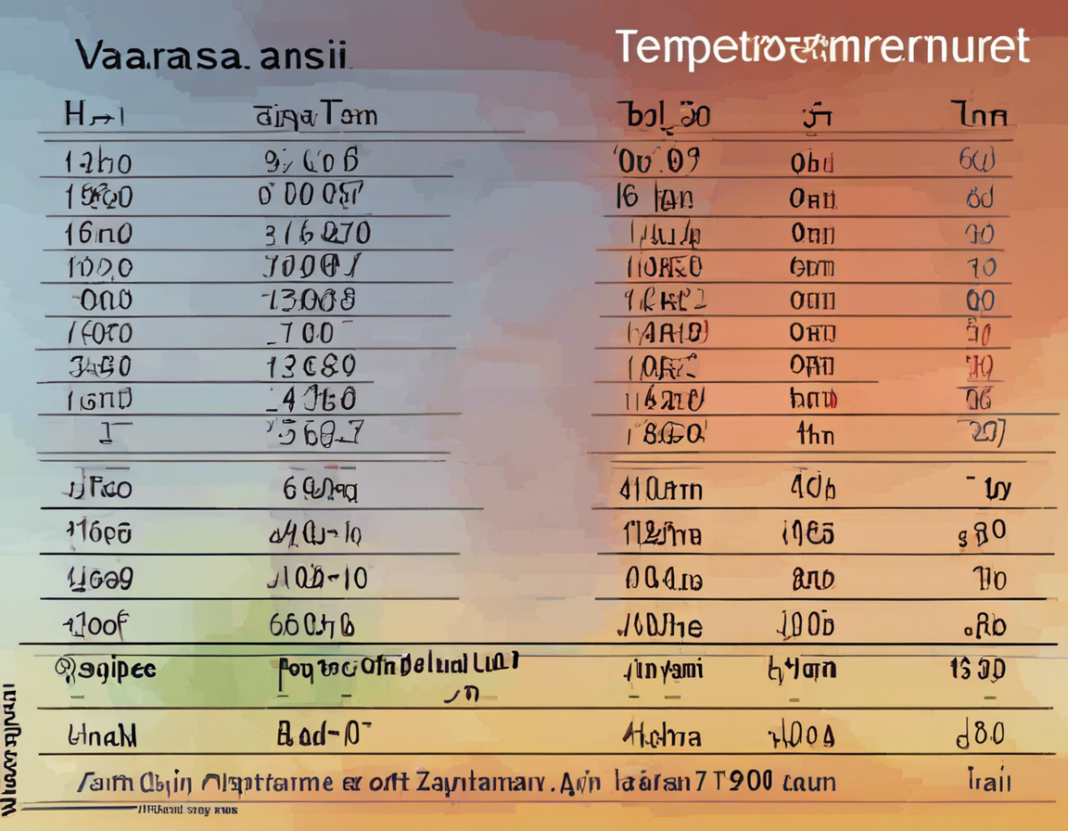Are you interested in learning more about the temperature in Varanasi? Situated on the banks of the sacred Ganges River, Varanasi is a city known for its spirituality, culture, and historical significance. Understanding the climate and temperature variations in this ancient city is crucial for planning a comfortable and enjoyable visit. In this comprehensive guide, we will delve into the temperature patterns in Varanasi, the best time to visit, and how to prepare for different seasons.
Understanding Varanasi’s Climate
Varanasi experiences a subtropical climate with hot summers, cool winters, and a significant monsoon season. The city witnesses all four seasons – summer, monsoon, autumn, and winter – with each season bringing its own unique temperature variations and weather conditions.
Summer in Varanasi (March to June)
Summer in Varanasi spans from March to June, with April and May being the hottest months. During this time, the temperature can soar to high thirties and even forties in degrees Celsius. The scorching heat and high humidity levels make it challenging to explore the city during the day. It is advisable to carry light cotton clothes, sunglasses, hats, and stay hydrated while visiting Varanasi in the summer.
Monsoon Season in Varanasi (July to September)
The monsoon season in Varanasi arrives in July and lasts until September. During this period, the city experiences heavy rainfall, providing relief from the sweltering summer heat. The temperature drops slightly, and the city comes alive with lush greenery. However, it is essential to be prepared for sudden downpours and carry an umbrella or raincoat when venturing out in Varanasi during the monsoon.
Autumn in Varanasi (October to November)
Autumn in Varanasi, spanning from October to November, is a pleasant time to visit the city. The temperature begins to cool down, and the weather becomes more comfortable for sightseeing and exploring the cultural treasures of Varanasi. Light cotton or breathable clothing is ideal for this season, as the days are warm, and nights are cooler.
Winter in Varanasi (December to February)
Winter in Varanasi, from December to February, brings cool and comfortable weather to the city. The temperature during this season ranges from 10°C to 20°C, making it an excellent time for tourists to explore the city and its numerous attractions. It is recommended to carry some woollens or layers for the chilly evenings and early mornings during the winter months.
Best Time to Visit Varanasi
The best time to visit Varanasi largely depends on personal preferences and the type of experience you seek. If you enjoy cooler weather and vibrant festivities, winter (December to February) is the ideal time to explore the city. The comfortable temperature and clear skies make it perfect for exploring the ghats, temples, and markets of Varanasi.
For those who appreciate the lush greenery and occasional showers, the monsoon season (July to September) offers a unique perspective of Varanasi. However, be prepared for sporadic rainfall and potential disruptions to outdoor activities.
If you prefer warmer weather and can cope with the heat, the shoulder months of spring (March to June) and autumn (October to November) can also be good times to visit Varanasi. Just ensure that you are equipped with appropriate clothing and stay hydrated during the hot summer months.
Tips for Dealing with Varanasi’s Temperature
-
Stay Hydrated: Regardless of the season, it’s essential to stay hydrated while exploring Varanasi. Carry a water bottle with you and replenish fluids regularly to avoid dehydration.
-
Dress Appropriately: Wear light, breathable clothing in summer, and layer up during winter. Carrying an umbrella or raincoat during the monsoon season is advisable.
-
Plan Outdoor Activities: Schedule outdoor activities like boat rides on the Ganges or exploring the ghats during the early morning or late afternoon to avoid the peak heat of the day.
-
Seek Shade: When the temperature is high, look for shaded areas or carry a hat to protect yourself from direct sunlight.
-
Monitor Weather Forecasts: Keep an eye on weather forecasts, especially during the monsoon season, to plan your activities accordingly and avoid heavy downpours.
FAQs about Varanasi’s Temperature
Q: What is the average temperature in Varanasi during summer?
A: The average temperature during summer in Varanasi ranges from the high thirties to forties in degrees Celsius.
Q: Does Varanasi experience extreme temperature variations throughout the year?
A: Varanasi experiences significant temperature differences from hot summers to cool winters, providing a diverse climate experience.
Q: What should I pack for a trip to Varanasi in winter?
A: For a winter trip to Varanasi, pack some woollen clothing, including sweaters and jackets, to stay warm during chilly evenings.
Q: Is it safe to travel to Varanasi during the monsoon season?
A: While Varanasi can be visited during the monsoon season, be prepared for heavy rainfall and potential disruptions to outdoor activities.
Q: How can I best enjoy Varanasi during the hot summer months?
A: To make the most of Varanasi during summer, plan your outdoor activities early in the morning or late in the afternoon to avoid the peak heat of the day.
Exploring the temperature in Varanasi offers a glimpse into the diverse climate of this ancient city and how it influences the visitor experience throughout the year. Whether you prefer the cool winters, the vibrant monsoon season, or the warmth of summer, Varanasi invites you to discover its rich cultural tapestry in every season. Next time you plan a trip to Varanasi, use this guide to help you prepare for the temperature variations and make the most of your visit to this enchanting city on the banks of the Ganges.
